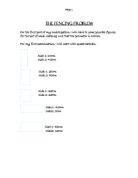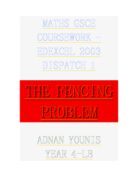Now I can see the repetition in some aspects of the working out. I have found that I have been using the Area of a triangle as a foundation, since it has to be used to find the overall Area of a polygon. I have also used the Tan function to find the height of each triangle. So now, with my knowledge so far I can derive a formula to find the Area for an n sided regular polygon.
I will start with the facts that I know about this shape: -
- Each of the sides are equal
- The perimeter is 1000.
-
Therefore one side = 1000 /n
- All regular shapes can be split up into equal triangles.
-
The number of sides will determine the number of triangles that can fit into the shape – The n sided shape has n amount of equal triangles in it.
-
Area of a triangle= X base X height
- Exterior angle of triangle = 360/n
Interior of triangle = 180 - 360/n
These facts have enabled me to derive a formula. Here is how I did it:
- For one triangle inside the n sided shape- the Area is:
X base X height
- For an n amount of triangles the Area is:
n( X base X height)
-
However, in the formula - n( X base X height)- what is the base and what is the height?
- The base of the triangle = the length of one side
-
Therefore the base = 1000/n
-
n( X 1000/n X height)
Now we have to find the height of the triangle.
Previously when finding the height we have had to use trigonometry before using the Area equation.
So, to find the height we will need to know an angle and a length.
We can place a perpendicular bisector through the triangle, which creates a right angle. Now we can use the Tan function to find the height. We know that the base of the triangle is 1000/n. The shaded angle in the diagram is equal to the exterior angle. The shaded angle is in the centre of the shape, and is divided up equally depending on the number of triangles. Therefore, the angle is 360/n, which is the same as the exterior angle. But to find out the height of the triangle we only need half of this angle:
X 360/n = 360/2n or simplified = 180/n
Now we have this shape:
We can use the Tan function to find out the height:
Tan (180/n)= Opposite/Adjacent or X 1000/n/height
Rearranged: Height= X 1000/n/ Tan (180/n)
Our new Area formula is:
A= n ({ X 1000/n} X X 1000/n/ Tan (180/n))
We can simplify this Area formula by multiplying out brackets to:
= n( 500/n X [500/n / Tan (180/n)] )
= n( 500/n X 500 /( n X Tan (180/n)) )
= n( 250000/n2 X Tan (180/n) )
= 250000/n X Tan (180/n)
This is the formula for an n sided shape with a 1000m perimeter. Now we can hastily work out the Area for 7 sided and other shapes.
If I now work out a series of regular shapes, starting at a heptagon, it may be possible to estimate what shape will have the largest Area.
Heptagon:
Area = 250000/n X Tan (180/n)
= 250000/7 X Tan (180/7)
= 74161.48 m2
It took only three lines of working to find out the Area, so it is clear that the equation is a much more efficient way of working out an Area of a regular shape. It is noticeable that the Area is still rising, so I should continue working out more Areas. I would like to see if the Area increases with the same rate, i.e. is the difference between a seven sided and eight sided shape the same as the difference for a three and four-sided shape. To do this I will also have to test much a bigger number of sides.
Octagon
Area = 250000/n X Tan (180/n)
= 250000/8 X Tan (180/8)
= 75444.17 m2
Nonagon
Area = 250000/n X Tan (180/n)
= 250000/9 X Tan (180/9)
= 76318.82 m2
Decagon
Area = 250000/n X Tan (180/n)
= 250000/10 X Tan (180/10)
= 74161.48 m2
11-sided shape
Area = 250000/n X Tan (180/n)
= 250000/11 X Tan (180/11)
= 77401.98 m2
12-sided shape
Area = 250000/n X Tan (180/n)
= 250000/12 X Tan (180/12)
= 77751.06 m2
13-sided shape
Area = 250000/n X Tan (180/n)
= 250000/13 X Tan (180/13)
= 78022.50m2
20-sided shape
Area = 250000/n X Tan (180/n)
= 250000/20 X Tan (180/20)
= 78921.89393m2
50-sided shape
Area = 250000/n X Tan (180/n)
= 250000/50 X Tan (180/50)
= 79472.72422m2
100-sided shape
Area = 250000/n X Tan (180/n)
= 250000/100 X Tan (180/100)
=79551.28988m2
I can see that the area is still rising albeit at a slower rate each time. There is clearly not much of a difference between the 50 and the 100-sided shape.
There are more faster ways of working out a series of equations- I.e. spreadsheets. However, before I do that, I shall work out one more area. If the area increases with the number of sides, the greatest area will be the shape with the greatest number of sides. The biggest number is infinity, so the shape with infinite sides has the biggest area. A circle is the only shape with infinite sides. As the number of sides on a shape gets bigger, each of the sides get smaller, and closer together. In the circle, the sides have become small dots that join up in a round fashion. Since the number of sides on a circle is infinite, you cannot use the equation. The letter n would become obsolete. So, you have to work out the area of a circle a different way. Again I will have to use the information I know to work out the area of a circle:
Perimeter/circumference = 2 x ∏ x Radius
Perimeter= 1000m
Area= ∏ X Radius2
Therefore:
1000m=2 x ∏ x Radius
Rearranged that equals:
Radius= 1000m/2 x ∏
=159.15m
Consequently, we can work out:
Area of circle= ∏ X Radius2
=∏ x (159.15) 2
=79577.47m2
The area of circle is clearly the greatest so far, and will be the greatest of all. I now have a range of results that will allow me to plot results on a graph and show how the area changes as the number of sides increase.
But before that, I will use a spreadsheet, to calculate a very large range of results, so that my graph will be as accurate as possible.
These results are very interesting. The graph clearly shows that the rate that the area increases at slows down dramatically, which tells me that there is not much difference in making a fence with 36 sides and 37 sides. The point for the area of a circle would be much to the right of this graph. Although there is no halt in the increase, the area only increases by a few hundredths at a time. The maximum point would be the circle, so the graph would never exceed 79577.47m2 in area. The results spreadsheet is more useful though. I had to split the equation up to easily get a result. You can clearly see how the area column increases very slowly after a while.
But what is interesting is that the equations denominator creeps towards the number PI --- 3.141593. If the equation n X Tan (180/n) is tending towards, PI then when the denominator actually reaches Pi the equation must be at its biggest point, i.e. the equation must equal the area of a circle. The area column also is very close to the area of a circle and continually gets bigger. I can show the relationship between these two – area and the denominator in a graph:
In summary this would mean that the area of the circle with 1000m circumference is 250,000/ ∏ that is a much quicker way of working out the area.
Conclusion
After looking at many different shapes there are a few basic conclusions that I have made:
- Regular shapes i.e. shapes that have equal sides, have bigger areas than irregular shapes. This is proved by the quadrilaterals and the triangles
- The more sides a regular shape has, the bigger area it has. (Pentagon, hexagon e.t.c.)
I have also learnt that the area for a regular shape with 1000m perimeter can be worked with a simple formula. To cover any other extension work, I could work out the formula for any regular shape by changing my formula like thus:
If I take my original formula in its least simple form I could alter my equation to deal with all perimeters:
A= n ({ X 1000/n} X X 1000/n/ Tan (180/n))
Since the Perimeter in this formula is 1000, I can replace 1000 with p (perimeter) each time. The new formula is:
A= n ({ X p/n} X X p/n/ Tan (180/n))
I can simplify this equation now:
A= n ({ X p/n} X X p/n/ Tan (180/n))
A= n (p/2n) X p/2n / Tan (180/n))
A= n (p/2n) X p/2n / Tan (180/n))
A= n(P2/ 4n2 x Tan(180/n))
A=P2/ 4n x Tan(180/n)
This is the formula for all regular shapes. The only area that this and my original formula will get unstuck is for circles. I have found out that a circle has infinite sides so when substituted into the equation:
A=250000/ n x Tan (180/n)
A=250000/ ∞ x Tan (180/∞)
This is not a workable equation. But after more investigation, I found out that the denominator of the original equation is equal to Pi when n is a very large number. So the area of a Triangle with a 1000m perimeter is:
A=250000/∏
However, it is possible to work out the area of a circle with any perimeter as a piece of extension work, if you devise another formula.
If you use the formula for above for 1000m circular perimeter, and convert it to the formula to find the area for any regular shape, you will get this formula for the circle.
A=P2/4∏
If we go back to the original question, we can see that the farmer wants to find the biggest area for her fencing. The biggest area has been shown as the circle in this investigation, as it has the greatest amount of sides possible, which is infinity. After using graphs and tables, and any previous knowledge, I have proved that the circle has the greatest area and the farmer should make a circular enclosure with her 1000m of fencing. This circle will have a radius of:
1000/ 2 x ∏ = 159.15m
And an area of:
A= 250,000/∏ or =79577.47m2 which is larger than any other shape shown in this investigation.







